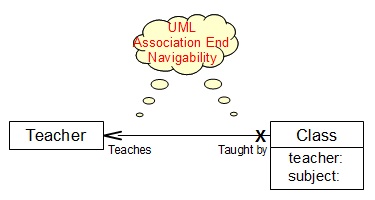UML Tutorials - Herong's Tutorial Examples - v1.05, by Herong Yang
Class Diagram - Association End Navigability Notation
This section describes the Association End Navigability Notation used in a UML Class Diagram. An Association End Navigability Notation specifies whether or not the instance of the connected class can be easily accessed through the related instance of the opposite class.
An Association End Navigability Notation is a graphical notation used in a UML Class Diagram to specify whether or not the instance of the connected class can be easily accessed through the related instance of the opposite class.
An Association End Notation may have the following basic elements:
- Navigable Association End - A line arrow is added on the association line near the association end.
- Not Navigable Association End - A cross sign is added on the association line near the association end.
For example, the "Teacher" class and the "Class" class have an association that "A teacher teaches in a class". In this association, the "Teaches" association end is Navigable, because the "Teacher" instance can be easily retrieved from the related "Class" instance through its "teacher" property. The "Taught by" association end is Not Navigable. Association end navigabilities of this association can be drawn in a UML class diagram as shown below:

Note that an association end may have unspecified navigability.
Table of Contents
Introduction of UML (Unified Model Language)
►UML Class Diagram and Notations
Class Diagram - Class Notation
Class Diagram - Association Notation
Class Diagram - Association End Notation
►Class Diagram - Association End Navigability Notation
Class Diagram - Aggregation and Composition Notations
Class Diagram - Generalization Notation
Class Diagram - Realization Notation
Class Diagram - Dependency Notation
UML Activity Diagram and Notations
UML Sequence Diagram and Notations
UML State Machine Diagram and Notations
UML Use Case Diagram and Notations